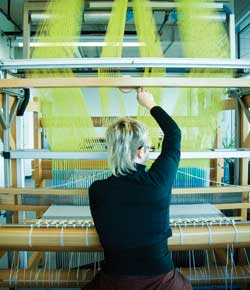Concordia Corner
Loom can handle 1,728 needles at once

Isabelle Sentenne demonstrates the use of the electronic loom located in the EV Building's Jacquard Room
Photo by IITS Creative Media Services
Tucked into a corner office on the tenth floor of the EV Building sits a digital loom capable of producing a four-by-five foot piece of woven fabric in four hours.
The Jacquard room loom is monitored by Hexagram’s textile coordinator, Isabelle Sentenne. It is available for the textile researchers who operate out of the Centre for Research/ Creation in Media Art and Technologies, as well as their graduate students.
Sentenne is responsible for the loom, one of four in Quebec, as well as other equipment, including an embroidery machine and digital textile printers. She was hired in Spring 2005, when the loom arrived.
“The loom can operate 1,728 different needles across the weft of the fabric,” Sentenne explained. Looms generally can manage four, eight or 12 frames of needles. “It’s like going from 12 to 1,728 dpi.”
The computer analogy is not that far off. Joseph Marie Jacquard invented the loom at the turn of the 19th century. He developed a system of punch cards that could block or allow individual needles to pass, creating a way to reproduce the desired pattern. The cards are reminiscent of early computer punch cards. Before his invention, nimble-fingered children were responsible for manipulating the individual threads.
The current digital loom accepts computer generated patterns and translates them into instructions for the needles. The precision of the program allows for the woven reproduction of digitized images. The computer operates on instructions that reduce all colours of the pattern into a black/white code. That also is reminiscent of computer programs that reduce commands to a 0/1 binary code.
Of course, the digital analogies only go so far. Weaving is, after all, a traditional craft. And much as the loom can weave quickly, it can take two people four days of full-time work to thread the machine properly. Developing the pattern can take weeks, if not months, of research and experimentation.
Sentenne learned the principles of weaving while studying at the Montreal Centre for Contem-porary Textiles (MCCT). As a designer, she considered fabric her primary inspiration. “When I realized I could go from a thread to the final garment, I was thrilled.” She did so with her thesis work at the MCCT, and produced the dress she wore to her wedding.
She finds the collaborative spirit at Hexagram inspiring. She also enjoys being surrounded by media artists who see the loom as a tool. It helps her stretch her own perceptions about the loom’s capabilities, since she comes from a more traditional background. “Maybe we can eventually experiment with conductive thread, or CMYK thread for the weft.”